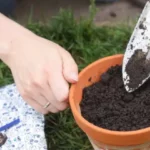As you consider starting your potato container garden, imagine the convenience of having fresh, homegrown potatoes at your fingertips. Picture the satisfaction of nurturing these root vegetables from seed to harvest, all within the confines of your own outdoor space. Growing potatoes in containers in layers offers a structured approach, but what lies beyond the initial steps?
Growing potatoes in containers in layers, also known as the layered or lasagna method, is a space-saving and efficient way to cultivate potatoes. Here’s how you can do it:
- Choose a Container: For this method, select a large, sturdy container with drainage holes at the bottom. A 5-gallon bucket or a stackable container works well.
- Add a Layer of Soil: Add about 3-4 inches of soil to the bottom of the container.
- Plant the Seed Potatoes: Place seed potatoes (whole or cut into pieces with at least 2-3 eyes per piece) on top of the soil, spaced evenly.
- Cover with Soil: Add another 3-4 inch layer of soil on top of the seed potatoes, leaving a few inches of space below the container’s rim.
- Add Another Layer: As the potato plants grow, add layers of soil covering the lower stems and exposing a few inches of the plants.
- Watering: Keep the soil consistently moist but not waterlogged. This method can be challenging to water, so monitor moisture levels closely.
- Harvesting: Once the plants have flowered and died back, potatoes can be harvested. Dig into the soil to remove the spuds, or turn the container over in a wheelbarrow or tarp to retrieve your grub.
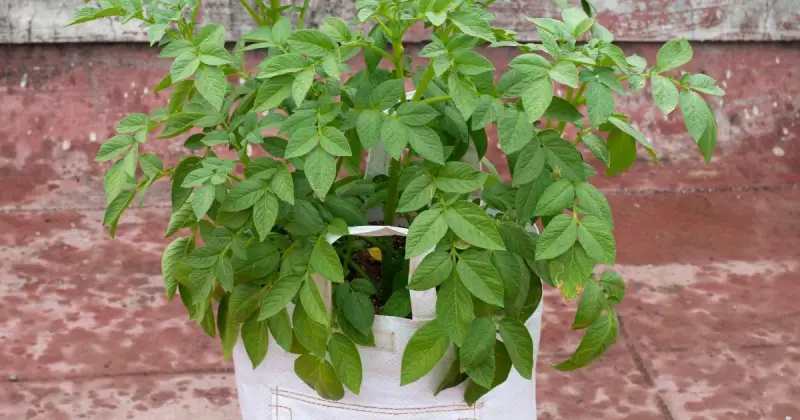
Growing potatoes in layers in containers can yield a good harvest in a small space. Additionally, this idea layered method helps conserve water and soil nutrients, providing another unique idea for backyard gardeners. Stay tuned to uncover the nuances that can elevate your potato-growing experience to the next level.
Humble Highlights
- Discover the unique benefits this soil layering lasagna method can provide for your spuds that enhance the environment of beneficial soil organisms to control pest populations AND allows more space for potatoes to grow vertically – potentially leading to higher yields than traditional methods.
- Save time by knowing what container size to sow your potatoes in AND how you can double your crop in the same container with soil layering so you can save space and boost production – making it ideal for balconies, patios, or even indoors.
- Save time with these 3 key watering and fertilization tips to enhance your potato layering process so you can improve soil structure AND help retain moisture, improving both structure and fertility over time.
Benefits Of Layering Soil For Potatoes
Layering soil for potatoes in containers enhances aeration, drainage, and overall root health, which is essential for the best tuber development. Stacking different soil layers within one container creates an environment that promotes healthier roots for your potatoes. This method decreases the chances of waterlogging and root rot by ensuring excess water can effectively drain through the different soil layers.

By providing varying nutrients in each layer, you offer the potatoes a diverse range of essential elements for growth. The layered structure also encourages tuber growth at different levels within the container, maximizing space utilization and yield potential.
Additionally, the layered soil facilitates the hilling process, where you can easily add more soil around the growing potato plants to encourage additional tuber formation. 1
Layering soil for potato growing can promote a more efficient use of nutrients. As you add soil layers and cover the growing potato plants, the lower layers of soil break down and release nutrients that the plants take up.
This continuous supply of nutrients can support healthy plant growth and potentially increase potato yields. The layering method can improve soil structure over time, leading to better aeration and drainage, which is essential for rigorous root development and overall plant health.
Choosing The Right Container Size
When selecting a container size for growing potatoes, consider the space requirements for the root systems and tuber development. Ideal container dimensions should allow proper soil hilling and room for the potatoes to grow and spread horizontally in layers. Ensuring the chosen container has sufficient depth and width is essential for the success and yield of your potato crop.
Container Size Considerations
To ensure ideal growth and tuber development for your potatoes, select a container that’s at least 16-18 inches deep. Your container should have a capacity of at least 10-15 gallons to allow the potatoes to develop tubers effectively. Larger containers ranging from 20-30 gallons are even better, as they provide ample space for multiple layers. 2
Ensure the container offers enough room to hill the soil as your potato plants grow. Sufficient container size promotes healthier root development and higher potato yields. Choosing the right container size creates ideal growing conditions for your potatoes, setting the stage for a successful harvest.
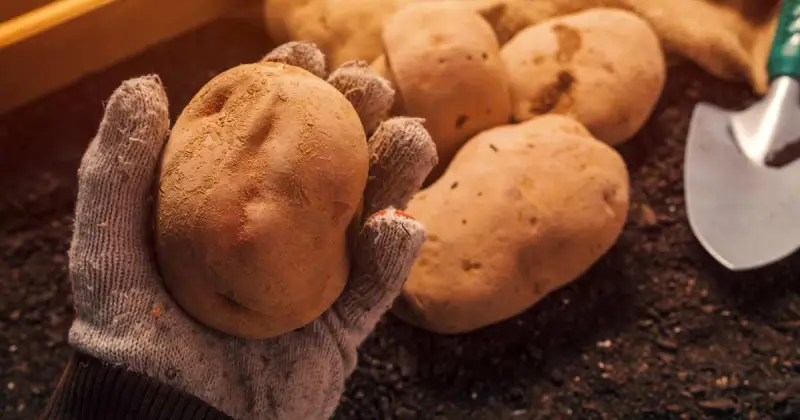
Space Requirements For Potatoes
When growing potatoes, selecting a container depth of at least 10-12 inches is crucial for ideal tuber development. Potatoes need adequate space to develop their roots and successfully produce tubers.
When considering container size, a 5-gallon container can typically accommodate 3-5 seed potatoes when planted in layers. Each layer of seed potatoes should have about 4 inches of space between them to allow for proper growth.
Larger containers, such as 20-30 gallons, are suitable for supporting multiple layers of seed potatoes, potentially leading to increased yields. The key is ensuring that each seed potato has enough room within the container to fully develop roots and produce tubers effectively in this layered system.

Optimal Container Dimensions
For ideal potato growth in containers, consider the dimensions for sufficient space for root development and tuber production. The best container dimensions for layering potatoes typically range from 18 to 24 inches in diameter and 24 to 36 inches in height.
Larger containers provide more room for soil and tuber development, increasing potato yields. On the other hand, a deeper container allows for better hilling practices, which promote healthier growth and increased tuber production.
When selecting the right container size, consider space constraints and available sunlight for favorable growth conditions. Proper container dimensions are essential to providing adequate root space, soil moisture retention, and air circulation for successful potato layering.
Proper Drainage Techniques
Proper drainage techniques are vital for successful potato cultivation in containers to prevent waterlogging and root rot. When growing potato plants in containers, ensuring they have sufficient drainage holes at the bottom is essential. These holes allow excess water to escape, preventing the soil from becoming waterlogged, which can lead to root rot and other challenging issues. Without proper drainage, the roots of the potato plants may suffocate and rot, ultimately affecting the overall health and yield of the crop.
Regularly check the drainage holes to ensure they’re clear and not blocked by soil or debris. Adequate drainage promotes healthy root growth, reduces the risk of disease, and supports the overall vigor of the potato plants in containers. 3
Some backyard growers believe using a layer of coarse material, such as gravel or broken pottery pieces, at the bottom of the container may not improve drainage as commonly thought.
This layer can sometimes create a perched water table, where water accumulates above the layer and does not drain properly. Instead, using a well-draining potting mix throughout the container is more effective and ensures proper drainage holes at the bottom.
Ideal Soil Mix For Potato Growth
An excellent growing mixture combines potting soil, garden soil, and compost to provide the necessary nutrients for your container-grown potatoes. To support best growth, make sure the mix is loose, well-draining, and pH-balanced around 5.0-5.2. A quality soil blend with good aeration and moisture retention properties will help your potatoes thrive and produce abundant yields.
Soil Mix Components
Potatoes thrive in a quality soil mix that retains moisture, provides essential nutrients, and supports healthy plant growth. The perfect soil composition is vital for excellent tuber development and overall plant health.
To nurture your container potatoes effectively, maintain consistent watering and fertilization practices alongside the balanced soil mix mentioned above. By prioritizing the right soil components, you set the foundation for a bountiful potato harvest in your containers.
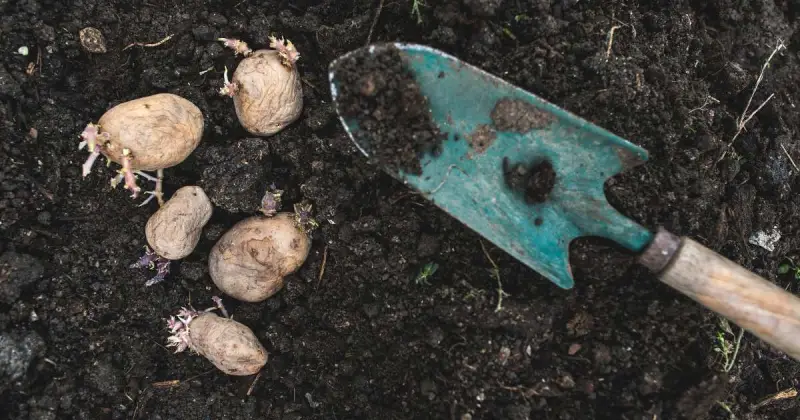
Proper Drainage System
Establishing a well-designed drainage system is crucial for developing and growing your container potatoes. It prevents waterlogging and root rot, allows excess water to escape, and maintains ideal soil moisture levels. 4
Good drainage ensures that the soil stays moist without becoming waterlogged, providing the necessary oxygen and nutrients for your potatoes to thrive in a container environment. Remember, a balanced soil mix with proper drainage is critical to successful potato cultivation in containers.
Utilizing this soil layering method for potato cultivation can help reduce the risk of pest damage. By regularly adding layers of soil, you can bury and protect the developing potatoes from pests like potato beetles or wireworms that may be present in the upper layers of soil. This method creates a barrier between the pests and the potatoes, making it more difficult for them to access and damage the tubers. Take a few minutes and watch the video below that explains the best steps for this unique approach while maximizing yields!
Monitoring Watering And Fertilization
Maintaining consistent soil moisture levels and appropriate fertilization are essential for ideal plant health and yield when growing potatoes in containers. To allow your container-grown potatoes to flourish, here are some crucial tips for monitoring watering and fertilization:
- Monitor Soil Moisture: Regularly check the moisture levels in the soil to determine when watering is necessary. Adjust the frequency based on the weather conditions and the growth stage of your potato plants to prevent issues like overwatering or underwatering.
- Use Water-Soluble Fertilizer: Opt for a water-soluble fertilizer to supply nutrients for healthy potato growth in containers. This allows plants to absorb better nutrients and supports robust development.
- Check for Nutrient Deficiencies: Check the soil for any signs of nutrient deficiencies, such as yellowing leaves or stunted growth. Adjust the fertilization regimen to address these deficiencies and promote ideal plant development. 5
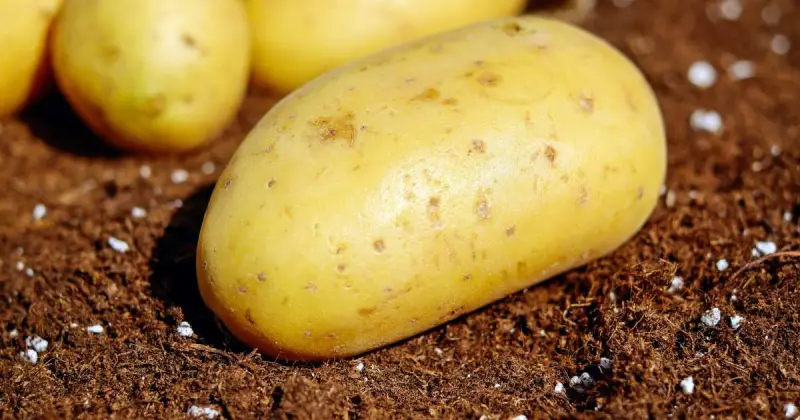
Harvesting Timing And Yield Optimization
For optimal potato harvests in containers, timing your harvests to coincide with yellowing foliage signals the potatoes’ maturity. Harvest your crop gradually to maximize your yield, allowing smaller potatoes to continue growing until they reach the desired size.
Typically, harvesting can begin around 10-12 weeks after planting, but this timing may vary depending on the potato variety and your preferred size. Regularly check the soil for mature potatoes by gently digging around the plant base to ensure you’re harvesting at the right time. 6
Striking a balance between harvesting new potatoes early and waiting for larger, mature tubers can help you maximize your overall yield. By monitoring the foliage color and periodically inspecting the soil, you can time your harvests effectively and make the most of your container-grown potato crop.
Conclusion
Growing potatoes in layers in containers is a highly efficient and practical method for cultivating these versatile tubers, which are quickly becoming widespread. You can optimize your harvest of delicious homegrown potatoes by choosing the right container size, ensuring proper drainage, using the ideal soil mix, and monitoring watering and fertilization.
And remember to harvest at the right time to maximize yield and enjoy the fruits of your labor.
Have you successfully grown potatoes in layers? Let us know in the comments below, and share with your fellow gardeners what steps you take to maximize potato yields in containers.
SOURCES
- ScienceDirect – An Exploration Of Preferences For Soil Health Practices In Potato Production
- Almanac – Growing Potatoes In Containers
- University Of Minnesota, Extension – Growing Potatoes In Home Gardens
- MDPI – Soil Water Dynamics, Effective Rooting Zone, And Evapotranspiration Of Sprinkler Irrigates Potato In A Sandy Loam Soil
- University Of Minnesota, Extension – Potato Fertilization On Irrigated Soils
- ScienceDirect – A Review Of Best Management Practices For Potato Crop Using Precision Agricultural Technologies




